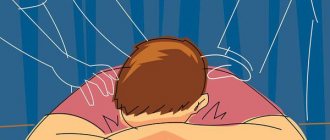Many people believe that obsessive-compulsive disorder only manifests itself in frequent hand washing or double-checking the closed front door. Moreover, in the minds of many, this disorder is idealized and romanticized, and has a certain mystique that confirms the pedantry, responsibility and accuracy of a person with OCD. However, this is a misconception. Obsessive-compulsive syndrome is much broader than just the thought of not turning off the iron; it is a condition that worsens the quality of life, causes discomfort to oneself and others, and also has the most tragic consequences.
What is obsessive-compulsive disorder, how to live with it and is it possible to get rid of it?
OCD is a disorder in which a person is constantly visited by intrusive negative thoughts. For example, that he could kill someone, or that he didn’t turn off the iron and his apartment would burn down, or that he could get infected from germs and die. Such thoughts are called obsessions.
Thoughts fall into two categories: aggressive and anxious. Aggressive thoughts include those in which a person is afraid of hurting or harming another person. For example, he worries that he will hit a child, hit his boss, or push someone onto the tracks.
Anxious - thoughts of danger. For example, fear of getting infected, fear that the house will burn down, war will happen, or the end of the world will come.
The thought is necessarily unpleasant, negative, terrifying. She comes to consciousness out of nowhere, suddenly and illogically. In fact, most people have these thoughts. And that's absolutely normal. The difference between an ordinary person and an OCD person is that the former does not separate these thoughts from the general flow. The thought came, the man thought it over and said goodbye to it. A person with OCD, in turn, focuses on thoughts. She gives him no peace. An emotion appears, an anxiety that needs to be calmed. And then the person tries in various ways to cope with these obsessive unpleasant thoughts. Certain actions and compulsions begin to help him in this.
For example, washing your hands frequently and thoroughly so as not to get sick, double-checking the closure of the door so as not to be robbed, avoiding sharp objects so as not to harm yourself.
It is the incorrect perception of obsessive thoughts that contributes to the development of obsessive-compulsive syndrome.
Stages of the disease
In terms of the perception of a mental disorder by one’s own consciousness, each person goes through three mandatory stages:
- Misunderstanding. The same feeling that appears along with the first symptoms of the disease. An incomprehensible and unusual state, it is unclear where disturbing thoughts are coming from and equally incomprehensible actions. All this causes wild, animal fear. Most likely, a person with the early stages of obsessive-compulsive disorder knows absolutely nothing about this mental disorder. And even if he has heard about him, he in no way suggests that this is what he is rapidly developing.
- Understanding, but not awareness. After the diagnosis is made, the patient understands that he still has the disorder. However, the brain stubbornly refuses to recognize the complexity of the situation. It remains unknown what the hope is based on that everything will go away by itself. Periodically, attempts arise to resist obsessive thoughts and actions. At this stage of the development of obsessive-compulsive nervous disorder, the main task is not to lose faith in yourself and in the ability to live an ordinary life.
- Adoption. This is the most important and responsible period of the disease. A person recognizes and accepts himself along with the mental disorder present. He understands that obsessive thoughts are the result of a nervous disorder and must be dealt with. He learns to control his actions, although this is not easy, and not completely go into an alarming pathological state.
Possession of information is of great importance. If a person intends to cope with OCD as quickly as possible, then in addition to professional help, it is necessary to independently study the mechanisms of the disease. Not always, but in some cases, it can be quite possible to take control of anxious thoughts and think about something more pleasant.
Signs of OCD
You can suspect obsessive-compulsive syndrome in yourself or your loved ones based on the following signs.
1. Scrolling negative thoughts and images in your head.
For example, the thought that you might hit a child or spit in your boss's face. Or an image where you are doing something out of the ordinary in a public place.
2. The emergence of irrational anxiety.
You are suddenly overwhelmed by a feeling of fear and anxiety, for no real reason. You feel in danger.
3. Fear of germs.
4. Tendency to constantly double-check everything.
You remember that you already closed the door, but you will feel safer if you double-check it again.
5. Hoarding.
It is difficult for you to part with objects and things that, in an amicable way, should long ago be sent to a landfill. You see the necessity and meaning of their presence next to you.
6. Obsessive counting.
Before an important task, you need to make an account. For example, count to 10 before speaking to a person in a public place.
7. Unhealthy pedantry.
Love for cleanliness and order is commendable. But when you run away from problems by cleaning or feel discomfort if you haven’t washed the already clean floors, these are the first signs of OCD.
What should the patient's relatives do?
The most important thing is not to reinforce the painful state of your loved one. On the contrary, this disease should be actualized and brought to the surface. Talk about it and guide the person to solve the problem on their own, but offer support. The key emphasis is on the fact that you are nearby and ready to back up: “I am with you, and we will do this together.” Another important factor is the development of the patient’s emotional intelligence. Encourage him to express and express feelings and emotions, even the most insignificant ones. Show your loved one how to show feelings.
Causes of obsessive-compulsive disorder
Many people are concerned about the risk of “contagion” of OCD and the reasons for its appearance. Scientists have conducted studies examining factors that influence the development of OCD.
Genetic predisposition. Mutation of a group of genes responsible for the distribution of the hormone serotonin increases the likelihood of developing OCD. Heredity. Children whose parents suffered from OCD are at risk of developing the disorder as well. Autoimmune. Streptoderma, acute tonsillitis, scarlet fever and other infectious diseases suffered at an early age affect the development of OCD. Purchased. This includes any trauma at birth. Strictness and perfectionism of parents. Excessive demands on yourself and children can provoke OCD.
Preventive actions
It is better to prevent any disease in time than to treat it. This also applies to obsessive-compulsive disorder. Most mental disorders develop in early childhood, so some degree of blame for their development lies with the parents.
The main thing is to help the child form an opinion about himself and his role in society. Adequate self-esteem is an important part of raising a healthy personality. The feeling of one’s own inferiority or, conversely, superiority is the reason for the formation of complexes, fears and anxious thoughts in the future.
Preventive measures include:
- calm, friendly relations between parents and other family members;
- elimination of factors that can traumatize the psyche;
- exclusion of physical punishment in the educational process and methods of influence that humiliate the individual.
If any of your relatives have ever suffered from OCD, then there is a risk of heredity. It is necessary to lead a calm lifestyle, avoiding irritants.
Exercise or yoga has an overall positive effect on the psyche as a whole. The use of alcohol or drugs can serve as an impetus for the development of obsessive anxiety states or aggravation of existing ones. Excessive passion for computer games and almost continuous use of social networks have a similar effect.
Some statistics on OCD
Obsessive-compulsive personality syndrome, according to statistics from various authors, occurs in 2-3% of people.
The first signs in 30-50% of cases appear in childhood and adolescence. Gender differences have not been established, as well as the influence of social and financial status on the appearance and development of the disorder. However, some authors have found a pattern between educational level and OCD.
The syndrome is more common in people with higher education and those whose work involves intellectual activity. The listed statistics, although they give an idea of the OCD situation in the world, are not accurate due to the fact that most “sick people” do not turn to specialists. But people with obsessive-compulsive disorder can be found in literature and cinema.
Features of behavior in OCD
People who have obsessive-compulsive disorder are characterized as follows:
- responsible executors. They strictly follow self-invented rituals, afraid to somehow violate them;
- demanding managers. These people not only follow their own rules, but also demand this from those around them, and not many are able to endure this;
- believers in omens and superstitions. They are convinced that all thoughts must materialize, so they need to think only about positive things, and the ritual actions performed by them will speed up this process.
Quite often it happens that a person for a long time observes the presence of disturbing thoughts and, following them, obsessive actions, but for some reason does not seek help from specialists. Most likely, the patient thinks that all this is a temporary phenomenon. For example, he is tired, has experienced another stress, etc. - this is how he himself tries to find an excuse for his problem.
However, a miracle does not happen. The symptoms only get worse. With obsessive-compulsive disorder, or rather, its active stage, voluntary self-healing almost never occurs.
Another distinguishing feature of OCD from other mental disorders is its persistent resistance to certain types of therapy. It is for this reason that an integrated approach is most often used for treatment. Self-help methods that show effectiveness in blocking the symptoms of similar diseases also do not have the desired result.
Obsessive-compulsive disorder in culture
To have a clearer idea of OCD, let’s remember examples from movies.
The film “Day of the Psycho” is dedicated to the exact daily routine, strict rituals, attitude towards others and behavior in society of the main character Adam (played by Marek Kondrat).
In the movie As Good As It Gets, the main character Melvin Adell (played by Jack Nicholson) also suffers from OCD. He often washes his hands, and only in boiling water and with a new product each time, always wears gloves, eats exclusively with his own utensils, is afraid of stepping on a crack in the road, avoids touching strangers, has his own ritual of turning on the light and closing the lock.
Scrubs' character Dr. Kevin Casey (played by Michael J. Fox) has many OCD rituals. He enters the hospital building three times, touches everything in the first patient's room, repeats the "bing" formula, and wipes off any stains that catch his eye.
The film Dirty Love vividly depicts the OCD symptoms of the main character Mark (played by Michael Sheen), due to which he loses his wife, home and job.
In the TV series Girls, the OCD of the main character Hannah Horvath (played by Lena Dunham) manifests itself in constantly counting to eight.
The main character of Detective Monk (played by Tony Shalhoub) brushes his teeth 12 times a day and flosses every 90 minutes.
In the TV series "The Big Bang Theory", the main character Sheldon Lee Cooper (played by Jim Parsons) dictates his own rules and conditions for everyone to be around him due to OCD. He is terrified of germs, does only familiar things with familiar people, sits only in a certain place on a common sofa.
The heroine of the series "Glee" Emma Pillsbury is obsessed with order and cleanliness due to OCD. Just like Monica Geller from Friends.
Symptoms of OCD in children
Parents should be alert to the following signs:
- Irritability
- Difficulty making decisions
- An inexplicable desire to be alone
- Refusal to communicate with friends
- Required to stay home or at school to complete assignments
- Excessive time spent on daily tasks, trouble sleeping
- Extreme reactions to minor changes in daily life
Children and adolescents are more likely to experience harm-related symptoms than adults. Typically, children obsessively ask adults to calm them down. They often crave routine and consistency. Only a qualified specialist can make a differential diagnosis, as well as suggest methods of correction or therapy.
Diagnosis of obsessive-compulsive disorder
Today, the diagnosis of OCD is based on the International Classification of Diseases, 10th revision (ICD-10).
ICD-10 has the following diagnoses for the disorder we are considering:
OCD. Predominantly intrusive thoughts or ruminations;
OCD. Predominantly compulsive actions;
OCD. Mixed obsessive thoughts and actions;
Other obsessive-compulsive disorders;
Obsessive-compulsive disorder, unspecified.
Scientific concept
Like all known diseases, obsessive-compulsive nervous disorder is included in the ICD-10. This is the generally accepted International Classification of Diseases, which is periodically revised and modified (the number corresponds to the revision number). The description of this mental illness in the classification of this revision is located in section F42.
According to ICD 10, OCD is characterized by stereotypical, obsessive thoughts that are periodically repeated and prompt forced actions. Thoughts are perceived as one’s own, even if they are contradictory or disgusting, and are positioned as a kind of sign for a ritual. The purpose of these repeated actions is to prevent possible troubles that allegedly threaten either the performer himself or his loved ones.
In rare cases, the patient understands that obsessive thoughts are absurd, and subsequent behavior does not have the expected effect. However, attempts to resist obsessive ideas and impulses do not produce positive results. Suppressing compulsive actions inevitably leads to an increase in anxiety.
From a physiological point of view, the development of obsessive-compulsive disorder is facilitated by pathological changes in such parts of the brain as:
- basal ganglia;
- frontal cortex;
- caudate nucleus;
- amygdala.
The disease is determined by serotonin dysfunction. There is a failure in the interaction of serotonin with the above structures and, as a result, there is a disruption in the process of transmitting impulses by neurons.
General criteria for defining the disorder
:
obsessive thoughts and/or actions; they should appear in most cases over a period of at least two weeks; obsessions/compulsions are a source of stress for a person; the thought of implementing an action is unpleasant for a person; thoughts, ideas and impulses must be unpleasantly repetitive; compulsive actions do not necessarily have to correspond to specific thoughts or concerns, but should be aimed at relieving the person of spontaneously arising feelings of tension, anxiety and/or internal discomfort.
Obsessive thoughts and compulsions
People with OCD usually realize that their thoughts and habits do not make sense. They spin these thoughts, follow the impulses, not because they like them, but because they cannot refuse them. And if they stop, people with OCD feel so bad that they start again.
Intrusive thoughts can often include:
- Concerns about yourself or others who have been or may be harmed
- Constantly checking blinking, breathing, or other bodily sensations
- Suspicion of a partner of infidelity, without reason.
Compulsive habits can often include:
- Doing tasks in a certain order every time or a certain “right” number of times
- The need to count, for example, steps or steps
- Fear of touching a doorknob, using a public restroom, or shaking another person's hand.
Complications of OCD
Obsessive-compulsive syndrome, in addition to worsening the patient’s quality of life, is also dangerous because it affects the development of other mental disorders. For example, depressive disorders, anxiety disorders, and suicidal thoughts may occur.
This is due to the fact that a person cannot get rid of OCD. There are also frequent cases of abuse of tranquilizers, alcohol, and other psychoactive substances, which, of course, only aggravates the course of the disease.
Depending on the degree of neglect of the disorder, the optimal method and type of treatment is selected. The following techniques can be used:
psychotherapeutic influence; drug therapy; family and social rehabilitation.
Manifestations of the disease
Obsessive-compulsive disorder develops gradually and can be easily recognized in the early stages. Signs characteristic of this mental disorder include sudden mood swings or illogical behavior that goes beyond generally accepted norms and beliefs. The patient's condition can be described as depressed and anxious; performing usual daily activities causes difficulties.
Depending on the stage of the mental disorder, a person may experience the following symptoms:
- physical – pain, weakness, insomnia;
- emotional – anxiety, fear, sadness;
- cognitive – memory impairment, false beliefs, problems with clarity of thinking;
- behavioral - aggression or, conversely, apathy, problems with hygiene and banal self-care;
- perceptual - a person considers himself chosen because he hears voices and sees various visions.
In practice, the disease can be expressed not only by banal frequent hand washing (when OCD is mentioned, this is exactly what first comes to mind), but also by other manifestations. For example, this could be: using wipes to clean the surface of the skin from non-existent dirt, avoiding contact with any surfaces outside the home. The patient is driven by the fear of contamination or infection with a serious, incurable disease.
The desire for symmetry is another obsessive condition and it may well be a manifestation of obsessive-compulsive disorder. If the desire to arrange all the things around you in a symmetrical order is so irresistible, then only a qualified specialist can help.
The presence of at least one of the above symptoms is a reason for diagnosis, and the presence of several manifestations is an indicator for immediate contact with a specialized medical institution.
The development of OCD is not tied to a person’s age category or gender. This disorder can begin to progress at any age and is equally likely to occur in both men and women.
Treatment of obsessive-compulsive disorder
In the treatment of OCD disorder, the cognitive-behavioral method of psychotherapy has proven effective. This approach was developed specifically to address OCD symptoms.
It is based on awareness of the disease, recognition of its manifestations and learning to resist them until complete control over the situation is gained. Individual psychotherapy sessions are recommended until the patient begins to distinguish obsessive obsessive thoughts from justified anxious fears. Next, the emphasis is on changing compulsive behavior. After the measures taken, it is much easier to deal with them. Psychotropic drugs, in particular antidepressants and tranquilizers, are widely used to treat severe forms of OCD.
Dr. Shmilovich’s clinic “Alter” employs professionals who have all the necessary knowledge and competencies to help you or your loved ones cope with obsessive-compulsive disorder.
Sign up via the website or by phone
Obsessions
Obsessions are born regardless of a person’s desire, appear suddenly, and it doesn’t matter what the patient is doing at the moment. They usually express thoughts about danger, harm, risk.
It’s difficult to get rid of “impudent” thoughts. They are difficult to control. By focusing on obsessions, the patient’s emotional state worsens. Anxiety increases, fear appears, depression and apathy develop. Patients become irritable. They are overtaken by a feeling of despair and powerlessness: well aware of the absurdity of the thoughts being born, they cannot cope with them.
The patient is depressed, self-doubt arises, and self-esteem decreases.
Emotional disturbances entail physiological disruption in the body. Physiological symptoms of the disorder are expressed as:
- headache, dizziness;
- tachycardia, shortness of breath;
- nausea;
- fainting;
- hyperhidrosis;
- digestive disorders;
- increased urination;
- pallor or hyperemia of the skin.
According to the mechanism of occurrence, obsessions are divided into elementary and cryptogenic.
Elementary obsessions are born immediately after the action of the defining impulse. Their reason is known. A doctor, in a conversation with a patient with hypertension, described a stroke as a delayed prospect. The patient was so impressed by the news that he now suffers from the nagging thought that he will soon suffer a stroke and die.
Cryptogenic obsessions arise suddenly and, as the patient believes, have no apparent cause. That is, it is unknown what could have caused the impudent thought. In fact, there is a reason, it is only unconsciously ignored by the patient.
Despite the persistence of emerging ideas, a person tries to fight them. The struggle takes place in two ways: active, passive. During an active battle, there is a confrontation with insidious thoughts: a person is afraid to fly on an airplane, but stubbornly chooses this type of transport for travel. The passive way is an attempt to switch attention to other objects. Avoiding unwanted thoughts. Safe behavior: if you are afraid of trains, do not ride the train.










